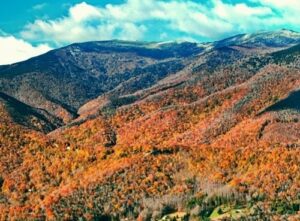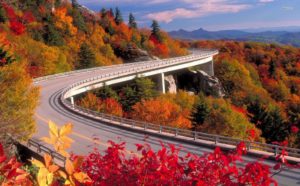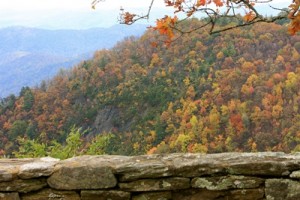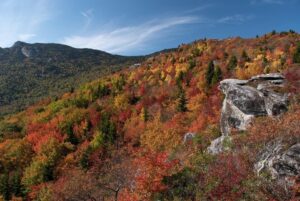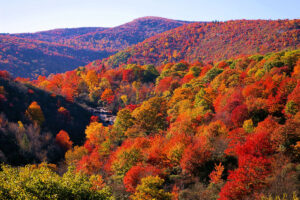NC Fall Foliage
The NC fall foliage season is one of the longest of any in the United States. Fall foliage in North Carolina will start appearing in the highest elevations in late September in the North Carolina Mountains and in the Great Smoky Mountains. It will continue into early November in the lower elevations of the mountains. Peak fall foliage in the Piedmont takes place well into November.
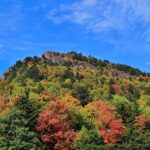
The highest elevations to change include Clingmans Dome in the Great Smoky Mountains National Park, Grandfather Mountain near Boone, NC, Mount Mitchell in Yancey County, and Waterrock Knob and Graveyard Fields on the Blue Ridge Parkway (between Asheville and Cherokee). The colors spread east across the state into the lower elevations all the way through November. Peak color can happen as late as the last week of October in areas with elevations below 2,000 feet. Lower elevations of the North Carolina mountains include Chimney Rock, Asheville, and Lake Lure. Other lower elevations that peak near the end of October include Asheville, Brevard, and Waynesville. Other areas in lower elevations to visit include Dupont State Forest and Biltmore Estate in late October.
When traveling in North Carolina in autumn to view fall foliage, there will always be an opportunity to view peak fall foliage somewhere in the state. North Carolina is fortunate to have about 4-6 weeks to undergo this show of nature as the warm days of summer transition into the cold days of winter. All the different areas of varying elevations provide the perfect state to catch a colorful fall foliage show. Each year the North Carolina mountains put on a beautiful show of fall colors to enjoy. From the Great Smoky Mountains to the Blue Ridge Parkway, Boone, Cashiers, Highland, Asheville, Lake Lure and more the state of North Carolina is a great place to travel and enjoy a colorful autumn.
Fall Foliage in the NC Mountains
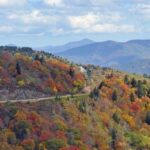
The fall foliage season in Western North Carolina and the Great Smoky Mountains (the Southern Appalachian mountain chain) is one of the longest fall foliage seasons on the East Coast. This is due to so many different species of trees in our mountains. With so many more different species of trees as compared to the areas in the far north, the fall foliage season in the North Carolina mountains and the Great Smoky Mountains can last as long as 8 weeks! And with the many different levels of elevations across the mountain chain in Western NC and on the Blue Ridge Parkway there is always a nice showing of color somewhere to enjoy during the fall foliage months.
To get Fall Foliage Weekly Reports and Updates for the Blue Ridge Parkway and Skyline Drive
visit Travel Blue Ridge Parkway/Fall Foliage
To get Fall Foliage Weekly Reports and Updates for the Great Smoky Mountains
visit Great Smoky Mountains Guide/Fall Foliage
To get Fall Foliage Weekly Reports and Updates for the North Carolina Mountains
Peak Fall Foliage in the North Carolina Mountains
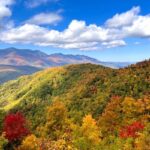
The key to the start of the fall foliage season is the weather. Fall foliage color display depends on the weather prior to September and October. A summer with adequate rain helps a lot. Followed by sunny days with cool air in early fall. What is not needed is drought conditions or high winds. Drought conditions dull the color. High winds from large storms or remnants of hurricanes result in trees dropping their leaves too early. The right weather conditions are crucial. A cool autumn with lots of sunshine is perfect. But no frost or below-freezing temperatures at night. Some years the development of color is better than other years. It all depends on Mother Nature!
Peak color happens in the highest elevations (over 5000ft) first and then works down to the lower elevations. Color changes usually start in late September in the highest elevations and continue into early November in the lower elevations. Elevation and the weather are so important to when and where color develops. In North Carolina, there is usually a 4-6 week window of opportunity to view the fall colors due to the varied elevations in the NC mountains.
The Travel NC web cam page has some nice webcam links to Asheville, Biltmore, and Boone
that show some pretty fall colors during the fall months. Take a look!
Great places to view North Carolina fall foliage would be:
Clingmans Dome – take US 441 through the Great Smoky Mountains (between Cherokee, NC and Gatlinburg, TN) Elevation of 6,643 feet.
The Blue Ridge Parkway – 469 miles long, the Blue Ridge Parkway winds around the NC mountains. From the VA/NC border all the way to Cherokee, NC
Mount Mitchell – in Yancey County, NC. Has an elevation of 6,684 feet and is the highest point east of the Mississippi River.
Grandfather Mountain – near Linville, North Carolina. Has an elevation of 5,946 feet. Just south of Boone, you can always find the best show of color somewhere in the fall months of September, October, and November.
Boone, Blowing Rock, and Banner Elk– north of Asheville. The Linn Cove Viaduct on the Blue Ridge Parkway at Milepost 304 is the most photographed site on the parkway.
Chimney Rock State Park – located at Chimney Rock in Rutherford County, NC. Near Lake Lure and just 25 miles south of Asheville.
Whiteside Mountain– between Cashiers and Highland in Jackson County, NC. Whiteside Mountain is part of the Nantahala National Forest. Has an elevation of 4,930 feet.
Highland, Cashiers, and Franklin – located in the Nantahala National Forest. A ride on US 64 between Franklin and Highland through the Cullasaja Gorge is beautiful.
Jefferson and West Jefferson – located in Ashe County and situated in the Appalachian Mountains. Mount Jefferson has an elevation of 4,665′. A view from the top of Mount Jefferson offers a beautiful view of Jefferson and West Jefferson down below.
Timing Is Everything! When To Go…
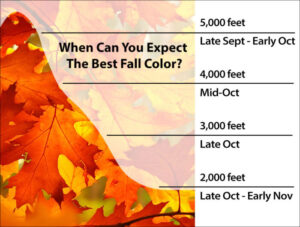
Typical Timing To View Peak Fall Foliage in NC Mountains:
Late September – Spotty color begins at elevations over 6,000 feet in the highest mountains.
First week of October – Color appears at or above 5,000 feet elevation, including Mount Mitchell and Grandfather Mountain.
Second week of October – color appears at the 4,000-5,000 feet elevations.
Third week of October – color spreads to the 3,000-4,000 feet elevations.
Fourth week of October – color makes it to the 2,000-3,000 feet elevations.
Early November- color spreads into the 1,000-2,000 feet elevations.
By late October and early November, the lower elevations of 1300 feet are changing. By the second week in November the peak season and the show are all but past for the mountain regions of North Carolina but in the lower elevations across the Piedmont to the coast fall foliage can last through late November.
The typical best times to plan a trip to view North Carolina fall foliage based on the past years would be:
● Western North Carolina Highest Elevations – Late September to Early October
● Western North Carolina – Early to Mid-October
● Western to Central North Carolina – Mid-October to Late October
● Central North Carolina – Late October to Early November
When planning a trip to NC to view fall foliage here is a general guide:
October 4-10
North of Asheville in the highest elevations above 5,000 feet is where the fall foliage show begins and is where the most color typically occurs. These areas include Mount Mitchell, Craggy Gardens on the Blue Ridge Parkway, Grandfather Mountain and Rough Ridge.
October 8-18
Fall foliage color will then start to appear in elevations greater than 4,000 feet. Areas including the Mount Pisgah, Black Balsam, Devil’s Courthouse, Waterrock Knob and Graveyard Field. Peak color also occurs in this time period for the Highlands area, including Whiteside Mountain and the Great Smoky Mountains National Park.
October 15-24
In the surrounding mountains of Asheville, there is plenty of color in the 3,000-4,000 foot elevation range. A ride north or south on the Blue Ridge Parkway from Asheville will be a beautiful sight this week. A ride through the Pisgah National Forest (Looking Glass Rock or Cradle of Forestry) normally is a great trip. North of Asheville Linville Gorge (Table Rock and Hawksbill Mountain) would be a nice fall foliage hiking trip.
October 20-30
The city of Asheville at 2,000 feet elevation has the peak colors during this time period, as well as areas around Hendersonville and Brevard. DuPont State Forest or the NC Arboretum are great places to enjoy the fall foliage colors. The Biltmore Estate in Asheville is also at peak leaf color during the latter part of October.
October 24-November 5
The fall foliage color show nears its end in the Chimney Rock area with an elevation of 1,300 feet. Visit Chimney Rock and Lake Lure for a last look at the beautiful fall foliage season in the North Carolina mountains for 2013. In late October and early November, the fall foliage show makes its way across the Piedmont region such as Greensboro, Winston-Salem, High Point, and Raleigh, and then spreads to Eastern North Carolina. The North Carolina coast has few hardwood trees so there isn’t much color change in the coastal region of the state.
Make plans to enjoy the NC Fall Foliage this year!
It’s just too pretty to miss!

